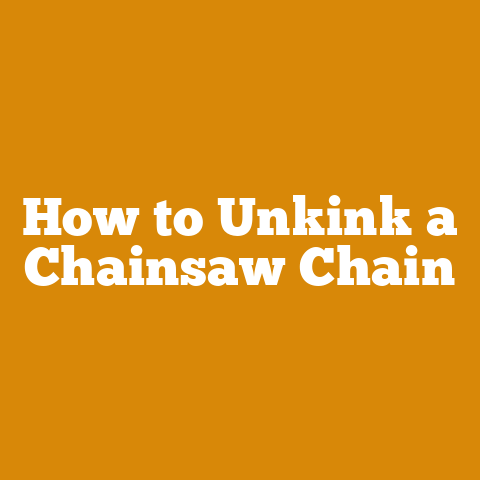How Long Should a Chainsaw Last? (Explained)
A chainsaw is an essential tool for many homeowners and professionals.
Knowing how long your chainsaw should reasonably last helps ensure you get the most value from your purchase.
This guide examines chainsaw lifespan and provides tips to extend the working life of your chainsaw.
Chainsaws are powerful tools that can make quick work of cutting and pruning tasks.
However, they also experience a lot of wear and tear during use.
With proper maintenance and care, you can expect 5-10 years or more from a quality chainsaw.
Many factors impact lifespan, including build quality, usage frequency, maintenance habits, storage conditions, and more.
With some basic preventive measures, you can keep your chainsaw running smoothly for years to come.
Build Quality Matters
Higher quality chainsaws from reputable brands generally last longer than cheaper models.
Look for chainsaws with features like:
- All metal construction: Plastic housing can crack over time. Metal guards better against impacts.
- Forged crankshaft: A forged (not stamped) crankshaft resists damage from vibration and shocks.
- Reinforced chassis: Internal ribs and guards protect components.
- Lab-tested motor: Rigorously tested for durability across various conditions.
- Fuel efficient engine: Uses fuel efficiently for longer running times.
- Robust starting mechanism: Starts easily year after year.
- Effective air filtration: Prevents dust, chips, and debris from damaging internal components.
In short: Carefully constructed, commercial-grade chainsaws outlast their cheaper counterparts.
Usage Frequency Matters
How often you use your chainsaw also impacts its lifespan.
Chainsaws meant for occasional homeowners may last 10-15 years.
However, professional models used daily last closer to 5 years before requiring extensive repairs.
Occasional use allows the engine to cool completely between uses while accumulating fewer operating hours.
The less you use your chainsaw, the longer it will last.
Just be sure to properly maintain and store it between infrequent uses.
Preventative Maintenance Is Key
Taking good care of your chainsaw ensures maximum lifespan. Here are key maintenance tips:
Regularly Inspect, Clean & Replace Parts
- Check controls and protective parts: Ensure smooth operation of throttle trigger, stop switch, chain brake, and hand guard.
Replace any damaged components. - Examine chain sharpness: Replace dull chains immediately for optimal cutting performance and engine health.
- Clean air filter weekly: Use compressed air to prevent debris from entering the carburetor.
- Check fuel lines and filters: Replace any cracked or damaged pieces to maintain proper fuel flow.
- Inspect sprocket: Replace excessively worn sprockets to prevent premature chain failures.
- Tighten loose bolts/nuts: Prevent further damage from vibration.
Properly Lubricate & Sharpen the Chain
- Oil chain before & during operation: Proper lubrication prevents rust and excessive wear.
- Sharpen every 5-8 tankfuls of fuel: Use proper file size and file angle to sharpen cutters and depth gauges.
Change Fluids
- Replace fuel mixtures older than 30 days: Stale fuel can clog carburetors.
- Change bar/chain oil annually: Old oil loses lubrication properties.
- Replace spark plugs annually: Ensure reliable ignition for easy starts.
Tip: Keep a chainsaw maintenance log noting service dates and tasks completed.
Proper Storage Extends Lifespan
Where and how you store a chainsaw between uses significantly impacts its longevity.
Best practices include:
- Store in a high, dry place out of reach of children and pets.
Avoid damp basements or sheds. - Drain all fuel and run the engine dry before longer term storage to prevent gummed up carburetors.
- Use fuel stabilizer in the tank/fuel container if storing less than 30 days.
This prevents stale fuel issues. - Place the chainsaw in a protective case or sheath.
Secure loose parts like bars, chains, air filters, and tools. - Disconnect the spark plug wire and cover the spark plug hole to allow airflow and protect from accidental starts.
Know When to Repair or Replace
While regular maintenance keeps a chainsaw running smoothly, parts do eventually wear out.
Here are signs it may be time for repairs or replacement:
Repairable Issues:
- Difficult/impossible starts
- Increased vibration
- Reduced cutting speed
- Replacing parts extremely often
- Constantly flooding
- External fuel leaks
Potentially Terminal Issues:
- Cracked engine housing
- Breathing exhaust fumes
- Unfixable fuel line issues
- Major mechanical failures
Repairs often cost 50-80% of a new chainsaw’s price.
At a certain point, investing in a new chainsaw makes more economic sense than continually replacing parts on an aging unit.
Average Lifespan Estimates
Given proper maintenance and storage, you can expect the following average lifespans from quality chainsaw brands:
- Homeowner models: 8-12 years
- Farm/Ranch models: 12-15 years
- Professional models: 5-8 years
However, with extensive repairs, some professional chainsaws log over 10,000 hours in their lifetime.
The range depends on total operating hours, usage frequency, care, and storage.
Follow this guide’s maintenance tips and a high-quality chainsaw should reliably serve you for years before needing replacement.
FAQs
Q: Does fuel type impact chainsaw lifespan?
A: Yes.
Use fresh fuel with the correct gas-to-oil ratios recommended in your owner’s manual.
Stale fuel can clog the carburetor and cause damage over time.
Q: Should I replace a chainsaw just because it’s old?
A: Not necessarily.
Well-maintained chainsaws can serve reliably for decades.
Gauge lifespan by overall condition and performance, not just age.
Q: Can I repair a chainsaw instead of replacing it?
A: In some cases, yes.
Things like fuel line issues, broken pulls cords, and worn sprockets can be economically repaired.
But issues like cracked housings or failing motors likely mean replacement time.
Q: Does blade length impact lifespan?
A: Yes.
Longer bars increase strain on the motor.
Use the shortest bar that still allows you to effectively cut your intended materials.
This reduces engine wear.
Q: Should I buy professional models even for home use?
A: Often, yes.
Commercial-grade chainsaws designed for rugged daily use have beefier parts and construction.
This leads to longer average lifespans through infrequent homeowner use.
Conclusion
The average chainsaw lasts 8-15 years, sometimes longer.
Lifespan varies based on build quality, usage frequency, preventative maintenance habits, storage conditions, and repairs over time.
Carefully choosing a reputable brand plus consistently maintaining, cleaning, and properly storing your chainsaw helps maximize its working life.
Know the repair vs.
replace tipping points for your chainsaw’s issues.
With this guide’s tips, your chainsaw can reliably partner with you for years to come.
Regular upkeep goes a long way to prevent premature breakdowns or replacements down the road.






